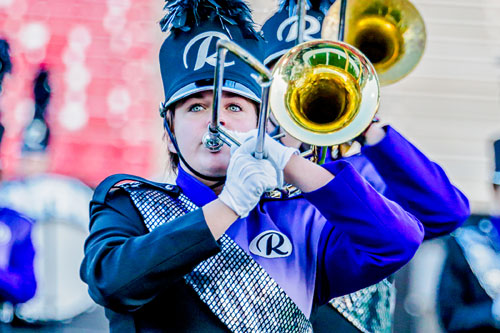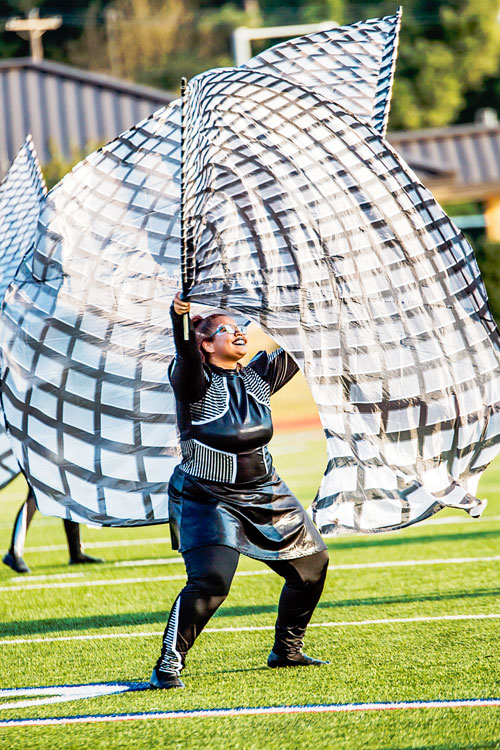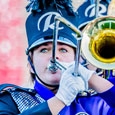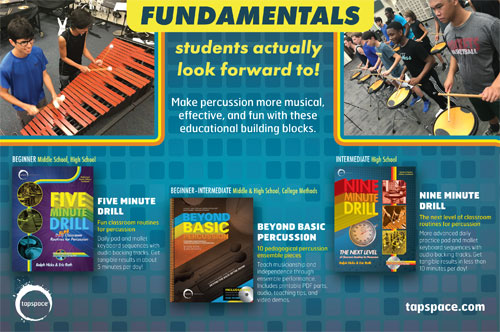There are many different philosophies regarding marching band, but these quick tips should be helpful to any band regardless of how much time and emphasis is placed on this aspect of the band program.
Procure a loudspeaker, bullhorn, or PA system like those made by MegaVox or Long Ranger; this is a must for every rehearsal. Not only will it save your voice, your band will not think you are yelling at them all the time.
Be realistic about the ability level of your students and always take inventory to see which sections are strong or weak – or possibly nonexistent. A good time to do this is right after the previous spring concert, but in some cases you can see it coming months sooner. You may need to start teaching someone a secondary instrument even before the spring concert. Next year’s band, on the whole, may be much younger than the group you have now. Keep this in mind when you program your show.
When considering music for the field, think at least one grade level lower than what you play during concert season.
If you are writing your own drill, ask yourself these questions: Is my drillwriting keeping this band from being the best it can be? Is there someone else available who can do it much better than I can? Be honest with yourself or ask a respected colleague who has seen your drillwriting efforts what they think.
When considering show design, carefully consider how often you are marching and playing at the same time. Don’t sacrifice musical quality with too much movement. Snappy drill formations are great, but means nothing if the tune that goes with it can’t be understood. When you are standing still, make sure it is in places where the music can stand alone very effectively.
Make your situation work. What matters is what you do with what you have. Don’t complain about the instruments you don’t have and be resigned to the problem. Work with the instrumentation you do have; that may mean rewriting a line to feature flutes and saxes instead of low brass. It can be just as effective and maybe even more interesting.
Don’t be afraid to look in your school’s gym classes to find potential auxiliary members. Some schools do a mini-unit on flag right in the gym classes.
Don’t hide the woodwinds. It is often impossible to hear them because they are found in a pretty arc 12 steps behind the back hash mark with a wall of brass shaped like a bullet in front of them. The woodwinds are placed in front during concert season, so let them spend some time there on the football field. There is no difference between being on a football field or in the band room.
Both asymmetrical and symmetrical forms are effective. Asymmetrical forms are often easier to clean and march because they are not a recognizable or definite shape. A triangle may take you 30 seconds to design, but three months to clean. Be cautious of drill designers who write too many obvious shapes for you. It is difficult for students to hold those perfectly straight lines of a triangle on a 32-count rotation.
Bands with fewer than 50 players should be careful placing wind instruments behind mid-field. Also, try to limit spread formations that go past the 35-yard lines. Company fronts built with eight or more steps between band members will not work.
Remember that once school starts, you will rarely if ever have such large stretches of rehearsal time with fewer diversions, so take advantage of the summer, particularly for the teaching of music and marching fundamentals. Questions to consider for summer marching camp: How much time do you need to accomplish your goals? What practice times work the best for your students? (Consider distance of travel from home, work schedules, athletic practices, teacher in-service, and the weather.) How much time should be devoted to the music, teaching drill, and instructing color guard?
Define your style. Make sure everyone has a firm grasp of how you want the marching basics performed. Break things down; demonstrate and demonstrate again. Teach only the techniques needed for your show.
Start rehearsals on time. You must enforce this from day one. Have a routine in place and make sure students know where they are supposed to be when rehearsal begins, whether it is the band room, sectionals, or on the field. Because there are numerous things that can delay a director at the beginning of a marching rehearsal, the drum majors should be well-versed in leading the group in stretches, marching fundamentals, and other daily routines.
If you or the drum major calls the band to attention, explain that attention means students stand with proper posture and horn positions with no talking or moving. Address what you want from day one, enforce it, and stick to it. Discipline on the small things sets the tone for your band before it even plays one note. Most people can tell if a group is disciplined by how they get off of the buses, how the uniform is worn, and how they walk to the field. It’s also a pretty good indication of how they are going to play.

photo by Trudy Weatherly
Downtime kills rehearsals. When having to address problems involving smaller numbers of students, have something for everyone else to do.
Don’t burn students out during rehearsal. Shorter, more frequent breaks work better than infrequent, longer breaks.
Make sure that everyone has a copy of the drill at every practice.
Prioritize your rehearsals. Pick a section of the show and work on that section thoroughly.
Don’t practice mistakes. Fix it before you move it. When cleaning drill from set to set, take a few seconds to stop and adjust each set. Fix the current set before you move on to the next set. Problems in earlier sets are sometimes compounded as the show progresses if they are not fixed immediately. If your practices consist of nothing more than doing run-throughs of your show, then you are simply reinforcing mistakes.
Use marching fundamentals that pertain to your show. Eight-to-five marching and box drills are great, but do not neglect practicing curvilinear forms if they are part of the show. Devise exercises that address these drill forms. This may take some time to develop at first. Use cones and yard markers to set the area of your circle or arc, and make sure each student marches around the cone so the form doesn’t condense. In time, your students will find that curved forms and arcs are easier to perform than company fronts. Once the students begin marching in relationship to each other, things will get easier.
Budget time in every rehearsal for marching basics in block formation, even if it is for only five or ten minutes. It also makes checking attendance easier. Don’t get down on your band for marching poorly if you don’t devote time to reinforcing the fundamentals.
Marching is nothing more than synchronized walking with some adaptations for instruments and style. Don’t break things down too far, or you’ll have your students questioning something they have been doing their whole lives—walking. Stress the following:
Plant the heel. Lock the knee of the extended leg. (The back leg should be bent slightly.) Get the toe as high as possible.
Have the ankle bones pass on the and of the count.
For proper upper body posture, align the hips, lift from the rib cage, relax the shoulders and roll them up and back, with the chin parallel to the ground. Marchers should feel buoyant as they march.
To get the best possible instrument carriage, students should pretend they are wading through a sewer and having to keep their arms out of the muck. Constantly remind them to “get your arms out of the sewer.”
When learning lateral slides, marchers should pull forward from the hips so that they avoid as much tension in the upper body as possible.
When marching laterally, percussion members “crab step.” Both hips will remain parallel to the front sideline, and the marchers will stay on their toes, as in a backward march, making sure the heels don’t touch the ground. Allow the toes of the foot in motion to cross under the heel of the foot in place. The feet should act as shock absorbers and keep the heels from touching the ground until he halt.
Use drill downs and drill ups to improve marching skills, concentration, and reaction time. For drill downs, put the students in block formation and have the drum major call out all the fundamental skills that have been taught. Begin slowly and then increase the speed of the commands. When you or the drum major sees a mistake, the offending marcher goes to the sideline and stands at parade rest. Increase speed until only one student is left. Students should do their best not to get caught. Much of the importance of this activity is learning how to make quick recoveries and hide mistakes.
For drill ups, recognize and remove students who are marching exceptionally well. They can then relax and watch the others, or leave if it is at the end of rehearsal. Do not try to embarrass the last remaining students, but talk to them individually about things they can do to improve.
Perform playing exercises during marching basics. As soon as a marching technique is taught, add a playing exercise to it. Scales and rhythmic figures work nicely. If your band has problems with step-offs, marching in-step, marching in-phase, or any other issue, perform the show music while marching in block band.
Consistently practice music fundamentals that improve rhythmic accuracy, extend ranges, clean articulations, and improve listening skills.
On each move, marchers should take every count to get to their drill set. They should not arrive to sets early or late.
Use subsets to clean drill. In a 32-count move, stop at 16, check the form, then go. In a 16-count move, check the form after 8 counts.
A good teaching tip when going from set to set is to add the next step. Upon arriving at the end of any one set, marchers should take one more step in the direction of the next move. It helps with body facings, weight transfers, and overall directional change. It also helps students learn the flow from set to set.
Teach the path. For example, when teaching drill, go from set one to set two several times, then turn the band around and march them back from set two to set one. This way you are teaching your students the path from set one to set two, not just the starting and ending points.
The drill is the movement, not the pictures. A drill set lasts for a split second. Focus more on the movement between sets, including step size, step style, horn angles, and body facings. Hitting the drill set is important, but how the band looks moving from one set to the next is much more important than just the arrival at set one or set two.
The integrity of the drill set comes first. All marchers must adjust step sizes to make the picture work. Try not to require any larger than a 6-to-5 step size for a student to make it to their set.
Students should march in relationship to each other, not the field. Hash marks and yard lines are reference points for teaching purposes; they’re not gospel. After a while, your students should be able to march the show on an empty parking lot with a great deal of success. Students should learn to march in relationship to each other and adjust for each other’s mistakes.
Use drill with a three-step interval most of the time.
Students should think ahead. If the next drill set move is eight counts, then a student should know where they are going next by count five. This concept of four counts ahead helps students anticipate and remember where their next drill set is. Their marching style tends to be less uncertain because they are thinking ahead and know where to go next.
Don’t forget to consider color guard equipment changes when writing the drill.
Let the design of the color guard equipment interpret visually what you are doing musically.

photo by Trudy Weatherly
Pulse is key. Use various devices, such as a metronome and P.A. system, wood block, counting out loud, or snare drummer playing on the beat, to set and maintain tempo while learning and cleaning drill.
Players in the back of the band should ignore what they hear and follow only the cues of the drum major. Those in the front of the group should listen back to hear what’s behind them, even if it seems out-of-phase with the conductor. Players should always know the source of the tempo, when to listen, who to watch, and what to ignore. Drum majors and band members should always stay with the section that has the pulse (usually the percussion section).
Because of sound delays, a silent count is a more effective way to start a song. If drum majors choose to count off aloud, they should at least conduct beats three and four silently to minimize sound delays.
If students can play in tempo, they can march in tempo. Drill pulse into the students’ heads from day one. Use a metronome for inside rehearsals as well as out. Spend a lot of your rehearsals inside marking time while playing. Don’t take it easy on the color guard when it comes to timing. Demand that their footwork be as precise as the wind and percussion players.
Make a habit of telling the band before each section you repeat or at least before an end-of-rehearsal run-through to improve at least one thing; this can be a marching or musical improvement. Ask them to think about what it is they are going to improve before you count them off again. Make a deal like this with your band: If you made five errors in marching and playing during the last run-through, then make four mistakes during this run-through. Depending on the size of your group, you could fix hundreds of mistakes at one time.
Make it work. Don’t get too bogged down by trying to stick exactly to what is on the drill sheet. The band roster may fluctuate many times throughout the season, and it is likely that drill will have to be adjusted. Some of the best jobs of drill adjustment are done at rehearsals on the fly. Also, don’t feel you have to have all drill changes down on paper. Major ones should be recorded, but for interval adjustments and small form reshapes this is unnecessary.
It is best to clean drill from a higher vantage point, so have a tower, ladder, press box, or scissor lift available if possible. Try to have some staff members on the field with the band to assist with cleaning. A high vantage point may not be possible at every rehearsal. Talk to the athletic director and coaches who use the football field. See if it is possible to wedge the band into the schedule once in a while. If practice on the main field is rare, then make sure all staff and band members are present to take advantage of the opportunity.
Take advantage of performance opportunities to get runs of your show. Soccer was in-season at my school in the fall, so I would have the band perform at soccer games held on the main field. Soccer games were sometimes held on the same night as my usual practice, and we could simulate game day conditions and the routine of getting ready to perform. It built respect between the band and the athletic program. The soccer fans loved us. It also made their sport feel appreciated. My band got to perform recently taught or changed material in front of an audience, and we accomplished all of this without ever leaving the school grounds.
Match up a veteran band member with one or two new members before the first practice. Allow time at the beginning and end of rehearsals for Band Buddies to meet and make sure the new members are taking care of business.
Be sure and clean up loose ends. Make everything as uniform and standard as possible, from how the hats are worn to how the instruments are held at attention. This takes up very little time, and shows discipline and attention to detail.
Finally, you cannot do it all. Look for qualified, mature people to work with your band. Make sure all of the band staff understands exactly what you want, then let them do their job.








